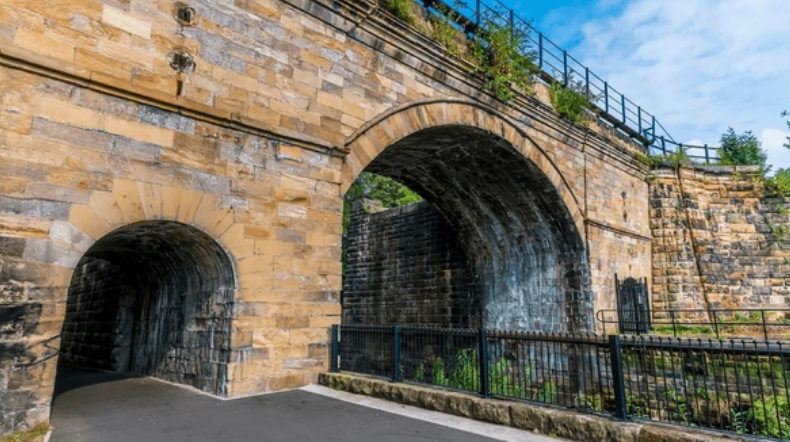Introduction: A Historic Journey Begins
On September 27, 1825, the world’s first public railway to use steam locomotives, the Stockton and Darlington Railway, opened in the northeast of England. This event marked the beginning of the Railway Age, a period of rapid industrialization and social transformation driven by the expansion of rail networks across Britain and the world. The Stockton and Darlington Railway not only revolutionized transportation but also played a crucial role in shaping the modern industrial economy, connecting distant markets, and facilitating the movement of goods and people on an unprecedented scale.
The opening of the Stockton and Darlington Railway was a momentous occasion, attracting crowds of spectators eager to witness this new technological marvel. The railway was the brainchild of visionary engineer George Stephenson, whose pioneering work in steam locomotive design would lay the foundations for the global railway boom that followed. This inaugural journey, with Stephenson’s famous locomotive Locomotion No. 1 at the helm, symbolized the dawn of a new era in transportation and the start of profound changes in society, industry, and commerce.
Read Also : Henry VIII Becomes King (1509): The Dawn of a New Tudor Era
The Vision Behind the Railway: Connecting Industry and Markets
The Stockton and Darlington Railway was conceived as a solution to the transportation challenges faced by the rapidly growing coal industry in northeastern England.
The Industrial Revolution and the Need for Efficient Transportation
By the early 19th century, the Industrial Revolution was transforming Britain’s economy, leading to a dramatic increase in the production of goods, particularly in industries such as coal mining, textiles, and iron. The demand for coal, which was essential for powering factories, steam engines, and households, had risen sharply, and coal mines in regions like County Durham and Northumberland were producing vast quantities of the fuel.
However, transporting coal from the mines to markets and ports was a significant challenge. Traditional methods, such as horse-drawn wagons and canals, were slow, inefficient, and expensive, limiting the growth of the coal industry and hindering the broader industrialization process. The need for a faster, more reliable, and cost-effective means of transportation became increasingly apparent.
It was in this context that the idea of building a railway to connect the coalfields of County Durham with the port of Stockton-on-Tees emerged. The railway would enable coal to be transported directly from the mines to the port, where it could be shipped to markets across Britain and beyond. This would not only reduce transportation costs but also increase the efficiency and profitability of the coal industry.
The Role of George Stephenson: A Pioneer of Railway Engineering
The Stockton and Darlington Railway owes much of its success to the vision and engineering expertise of George Stephenson, often referred to as the “Father of Railways.” Born in 1781 in Wylam, Northumberland, Stephenson had worked as a colliery engineer and had gained considerable experience in developing steam engines for use in coal mines. His deep understanding of steam power and his innovative approach to locomotive design made him the ideal person to lead the railway project.
Stephenson was appointed chief engineer of the Stockton and Darlington Railway in 1821, and he immediately set about designing a railway that could accommodate steam locomotives. At the time, railways were still a relatively new concept, and there was considerable skepticism about the feasibility of using steam power for transportation over long distances. However, Stephenson was convinced that steam locomotives could revolutionize transportation, and he was determined to prove it.
One of Stephenson’s most significant contributions to the project was the design of Locomotion No. 1, the steam locomotive that would be used on the inaugural run of the Stockton and Darlington Railway. Locomotion No. 1 was a groundbreaking machine, capable of pulling both freight and passenger carriages at speeds that were unprecedented at the time. Its success would pave the way for the widespread adoption of steam locomotives on railways around the world.
The Opening Day: A Milestone in Transportation History
The opening of the Stockton and Darlington Railway was a highly anticipated event, drawing large crowds and marking a major milestone in the history of transportation.
The First Public Run: Locomotion No. 1 Takes the Lead
On the morning of September 27, 1825, thousands of people gathered along the route of the Stockton and Darlington Railway to witness the inaugural journey of Locomotion No. 1. The locomotive, driven by George Stephenson himself, pulled a train of wagons carrying coal, flour, and passengers. This was not only a demonstration of the railway’s potential but also a public spectacle, as many had never seen a steam locomotive in operation before.
The train departed from the colliery at Shildon, traveled through Darlington, and arrived at the port of Stockton-on-Tees. Along the way, the train reached speeds of up to 15 miles per hour, a remarkable achievement for the time. The journey took several hours, and the sight of the steam locomotive puffing along the tracks captivated the onlookers. The success of this first public run demonstrated the viability of steam-powered railways and generated excitement about the future of transportation.
The opening of the Stockton and Darlington Railway was a symbolic moment in the transition from traditional modes of transportation to the modern, industrialized world. It marked the beginning of a new era in which railways would play a central role in the economic and social development of nations.
The Significance of the Event: A Catalyst for the Railway Age
The successful opening of the Stockton and Darlington Railway had far-reaching implications for the future of transportation. It proved that steam locomotives could be used effectively for long-distance travel and that railways could provide a reliable and efficient means of transporting goods and passengers. This realization sparked a wave of railway construction across Britain and eventually around the world.
The Stockton and Darlington Railway also had a significant impact on the coal industry and the broader economy. By reducing transportation costs and increasing the speed at which goods could be moved, the railway helped to lower the price of coal, making it more accessible to industries and households. This, in turn, fueled further industrial growth and contributed to the economic expansion of the 19th century.
Moreover, the success of the Stockton and Darlington Railway inspired other entrepreneurs and engineers to invest in railway projects, leading to the rapid expansion of the rail network in Britain. Within a few decades, railways had become the dominant mode of transportation, connecting cities, towns, and rural areas, and transforming the way people lived and worked.
The Impact of the Stockton and Darlington Railway: Transforming Society and Industry
The opening of the Stockton and Darlington Railway marked the beginning of a period of rapid change in British society and industry, driven by the expansion of the railway network.
Revolutionizing Transportation: The Expansion of the Railway Network
The Stockton and Darlington Railway set the stage for the rapid expansion of the railway network across Britain. The success of the railway demonstrated the potential of steam-powered transportation, and within a few years, numerous other railway lines were being planned and constructed. The Liverpool and Manchester Railway, which opened in 1830, was one of the most significant early railways, linking two major industrial cities and further proving the viability of rail travel.
The expansion of the railway network had a profound impact on transportation in Britain. Railways provided a faster, more reliable, and more efficient means of moving goods and people than traditional methods such as horse-drawn wagons and canals. This led to a dramatic reduction in transportation costs and travel times, making it easier for businesses to access markets and for people to travel long distances.
The growth of the railway network also had a significant social impact. Railways made travel more accessible to the general population, allowing people to visit distant relatives, explore new parts of the country, and experience greater mobility. The rise of rail travel also contributed to the growth of tourism, as more people were able to visit popular destinations such as seaside resorts and historic sites.
Boosting Industrialization: The Economic Impact of Railways
The development of the railway network played a crucial role in the continued industrialization of Britain. By providing a faster and more efficient means of transporting raw materials, finished goods, and workers, railways helped to drive the expansion of key industries such as coal mining, textiles, and iron production.
Railways also facilitated the growth of new industries, such as engineering and manufacturing, which were essential for the construction and maintenance of the railway network. The demand for iron rails, locomotives, and rolling stock created a booming market for these industries, leading to the growth of towns and cities along railway lines and the creation of thousands of new jobs.
The economic impact of the railways extended beyond individual industries. By reducing transportation costs and increasing the efficiency of trade, railways helped to lower the prices of goods, making them more affordable to consumers. This, in turn, contributed to the rise in living standards and the growth of the middle class, as more people were able to access a wider range of products and services.
The Legacy of the Stockton and Darlington Railway: A Lasting Influence
The Stockton and Darlington Railway left a lasting legacy, influencing the development of railways and shaping the modern world in profound ways.
The Global Influence of the Railway: Spreading the Technology Worldwide
The success of the Stockton and Darlington Railway had a ripple effect beyond Britain’s borders, inspiring the construction of railways in other countries and helping to spread the technology of steam locomotion around the world. The railway’s success demonstrated the practicality and benefits of rail transport, and soon, countries in Europe, North America, and beyond were building their own railway networks.
In the United States, the construction of the first transcontinental railway in the 1860s connected the eastern and western parts of the country, facilitating the movement of goods and people across vast distances and contributing to the nation’s economic growth. In Europe, countries such as France, Germany, and Russia developed extensive railway networks that played a key role in their industrialization.
The spread of railways also had a significant impact on global trade and communication. Railways enabled the faster movement of goods between countries, increasing the volume of international trade and helping to integrate the global economy. The ability to travel quickly over long distances also facilitated the spread of ideas, culture, and technology, contributing to the process of globalization.
Preserving the Heritage: The Stockton and Darlington Railway Today
The Stockton and Darlington Railway is remembered today as a pioneering achievement in the history of transportation. The railway’s legacy is preserved through various heritage sites, museums, and commemorations that celebrate its role in shaping the modern world.
One of the most important heritage sites associated with the Stockton and Darlington Railway is the Head of Steam – Darlington Railway Museum, located in the original North Road Station in Darlington. The museum houses a collection of historic locomotives, carriages, and other railway artifacts, and it tells the story of the railway’s construction, operation, and impact on society.
In addition to the museum, parts of the original railway line have been preserved and are still in use today, either as heritage railways or as part of the modern rail network. The legacy of the Stockton and Darlington Railway is also commemorated through various events and exhibitions, including the annual celebrations held on the anniversary of the railway’s opening.
The Stockton and Darlington Railway remains an enduring symbol of the transformative power of technology and innovation. Its success marked the beginning of the Railway Age, a period of rapid industrialization and social change that shaped the modern world. The railway’s legacy continues to inspire engineers, entrepreneurs, and historians, serving as a reminder of the profound impact that transportation can have on society.
Conclusion: The Enduring Impact of the Stockton and Darlington Railway
The opening of the Stockton and Darlington Railway in 1825 was a watershed moment in the history of transportation and industry. It marked the beginning of the Railway Age, a period of rapid expansion and innovation that transformed Britain and the world. The railway’s success demonstrated the potential of steam locomotion and set the stage for the development of the modern railway network, which would become the backbone of industrial society.
The legacy of the Stockton and Darlington Railway is evident in the global spread of railway technology, the profound economic and social changes it facilitated, and the lasting influence it has had on the development of transportation infrastructure. The railway’s impact can still be felt today, as railways continue to play a vital role in connecting people, goods, and ideas across the world.
As we reflect on the history of the Stockton and Darlington Railway, we are reminded of the power of innovation to drive progress and change. The railway’s story is one of vision, determination, and technological advancement, and it serves as an enduring example of how transportation can shape the course of history.
FAQ About the Stockton and Darlington Railway (1825)
Why was the Stockton and Darlington Railway significant?
The Stockton and Darlington Railway, opened in 1825, was the world’s first public railway to use steam locomotives. Its success marked the beginning of the Railway Age, revolutionizing transportation and contributing to the industrialization of Britain and the world.
Who was George Stephenson and what was his role in the railway?
George Stephenson, known as the “Father of Railways,” was the chief engineer of the Stockton and Darlington Railway. He designed the steam locomotive Locomotion No. 1, which was used on the railway’s inaugural journey, and played a crucial role in the development of railway technology.
What was the impact of the railway on the coal industry?
The Stockton and Darlington Railway significantly reduced transportation costs for the coal industry, making it more efficient and profitable. This, in turn, lowered the price of coal and contributed to the expansion of industries that relied on coal as a primary energy source.
How did the Stockton and Darlington Railway influence global railway development?
The success of the Stockton and Darlington Railway inspired the construction of railways in other countries, spreading railway technology worldwide. It demonstrated the viability of steam-powered rail transport and set the stage for the global expansion of rail networks.
How is the Stockton and Darlington Railway remembered today?
The legacy of the Stockton and Darlington Railway is preserved through heritage sites, museums, and commemorations. The Head of Steam – Darlington Railway Museum and other preserved sections of the original railway line celebrate its historical significance and impact on transportation history.







Thank you for writing this post! http://www.hairstylesvip.com